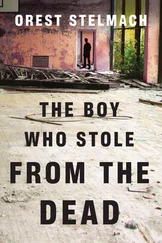To the left is a mural of Saint Gerard in his clerical dress. He is standing next to a skull and white lilies on a table. My great- grandmother pointed to that wall and said, "That is Gede." Then she sang a different song: "When they need me, they say I am Gede; when they don't want me, they say I am garbage…"
Those melodies will never escape from my memory.
"There are many, many lwas ," my great-grandmother told me. "Each one has a special song." She taught me the names of all the spirits and sang their songs so that I would pass that knowledge to my own great-grandchildren one day.
Today I live in Washington, D.C., thousands of miles and an ocean away from that peristil , from the lwas , the spirits, and images that inspired my great-grandmother's songs. But sometimes I find myself on that dirt floor and feel the grains of three hundred years against my skin. I see the rainbow of sequined flags decorating the walls and the center altar, covered with calabash bowls, oil lamps, and layers of candle wax that congealed in labyrinthine patterns. Sun rays filter through the holes in the tin roof, dust spirals heavenward; an avalanche of dreams buries me on that dirt floor, and I am born again.
I see the room that my great-grandmother had forbidden me to enter. I was five years old, holding her big hand, feeling safe among the marred faces of old women out of whose throats ancient chants soared above the flames of bonfires that burned for days to the relentless Kongo beat of goatskin drums. The elders agreed my eyes were much too young to view the secret room of souls and uncertain crossroads.
The last time I was home I went into that room. My great-grandmother had been dead for years; I felt that I had her permission somehow. The mystery quickly unfolded before my eyes. I had imagined that there would be more substantial things than the altars of cracked cement upon which stood small clay jars covered in layers of orange-colored dust, pieces of deteriorating fabric and broken black and red bead necklaces. The room itself was decaying. Several aluminum plates and containers made from dried calabash shells still bore the traces of disintegrated offerings: corn, sweets, yams and malanga just like they sold at Mashe Petyon, a picture of which hangs on my living-room wall.
It has been seven years since I have been home, but I visit Mashe Petyon every morning when I get out of bed with the scarf still tied around my head that keeps my dreams from falling. I look at the wall in my apartment and there they are: an ocean of black women squatting before their wide wicker baskets, their colorful skirts tucked between their legs. These women chatter among themselves, arguing and laughing with sheer abandon.
Sometimes, if the night before was easy, I'm right in there with them laughing as the morning sun travels across the sky, across the straw roof, along my black skin. I rest my head against the wall the way the sugarcane leans against the poles that hold the tent up above the marketplace and keep the invisible lines that divide secure. I know these women who sell bright yellow plastic plates, aluminum skillets, dried codfish, fried plantain, and charcoal. I recognize every one of their faces. Even when the painter exaggerates their features and makes their limbs like giraffes', I get inside the wooden frames and haggle with them the way my great-grandmother did when she took me along to buy the sugar she would sprinkle over sliced tomatoes for breakfast. With a hand cocked on her hip, a serious tone of voice, and steady vigilance in her smoky age-grayed eyes, she would ask for fifty cents' worth of oil, spices, a cup of rice, a pound of beef, and two eggplants to prepare the white-rice-and-legume supper.
It's been a lifetime since I was the little girl-child who sat on the porch at twilight with my great-grandmother, Madan Deo, to listen to her stories about women who shed their skin and took to the skies during the darkest hours of night. Madan Deo told me about the tall man who roamed the streets at midnight and spoke to no one. Met Minwi was his name, Master of Midnight. I always sat at her knees and faced her so that I would not have to look at the shadows which our little cotton tree threw onto the unpaved road. Shadows and the lamplight often resulted in such a macabre duet.
"Tim tint?" she would say before telling me a riddle.
"Bwa sech," I would answer, giving up quickly because my efforts to solve her riddles would rob me of the chance to hear more of the stories that her own grandmother must have told her. I wish I had asked her why she kept the old dress in which her mother, Madan Zepherin, had died. That dress hung on the wall for many years like a favorite picture.
One night, Madan Deo looked right past me toward the street beyond the porch and said, "Tim tim?"
Before I could answer, my great-grandmother stood and walked into the house. She said something about getting a cup of water and that she would return soon. She closed the door behind her to keep the insects from flying inside. Time went by and she did not return. I went to the door and tried to open it. It was locked.
"Bwa sech." I cried.
I turned to look at the dark road beyond the porch. The long shadow lingering at the foot of the porch told me that someone was there. I pounded on the door and called out to Madan Deo. "Bwa sech. Let me in. I give up. I am afraid."
It has been a lifetime since I was the little girl-child who huddled in the corner of the porch hiding and hoping that Met Minwi would not see me. I dared not breathe. The shadow waited at the porch. It had a pulse. Someone was there. 1 dared not look. I wanted to run inside the house, where Madan Deo would keep me safe throughout the night even if a hundred flying, skinless lougawous fell through the tin roof.
I opened my eyes for a brief moment. The long shadow stood still from behind the cotton tree-a few feet from where I was. I covered my eyes again and held my breath.
"Tim tim?" Madan Deo asked.
At last, she had come to save me. I took her hand and tried to pull her into the house. She shook me loose and told me, as she had done many times before, "Dyab pe dyab; dyab pa manje dyab." She told me there was nothing in this world to fear. Devils fear one another but one cannot destroy the other without destroying himself. I looked into the street and saw the long shadow inching away. It passed before the porch but I did not see him.
"I wanted you to see him," my great-grandmother whispered. "I wanted you to see him the way Madan Zepherin made me see him. Because until you look him in the eye and learn that you can still survive, you will always be afraid of something in this life."
It's been seven years since I walked by the melting black candles and plates of food offerings at the shrine of Baron Lakwa on the way to visit my great-grandmother's grave at Petionville's cemetery. I thought of the stories Madan Deo recounted about Baron, a lwas who stands guard at the crossroads between this life and the other. I thought about the Gede, the spirit that danced in my grandmother's head. They say Gede Nimbo, the protector of children, was her favorite. One of the rooms in the peristil was dedicated to him. When I held her hand as a child, during the ceremonies, people often called her Papa Gede. And they would point at me and say, "That child is Gede's granddaughter."
"Devils may fear one another," I can hear Madan Deo say from beyond, "but one cannot destroy the other." And I wonder…
Had I not covered my eyes on that warm night so long ago, I would not wake up every morning in search of shadows between the brushstrokes of a painter's version of Mashe Petyon. And perhaps I would not be so afraid to go home today.
Читать дальше












